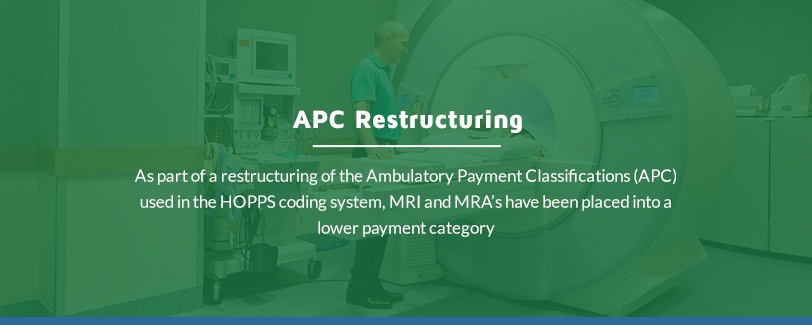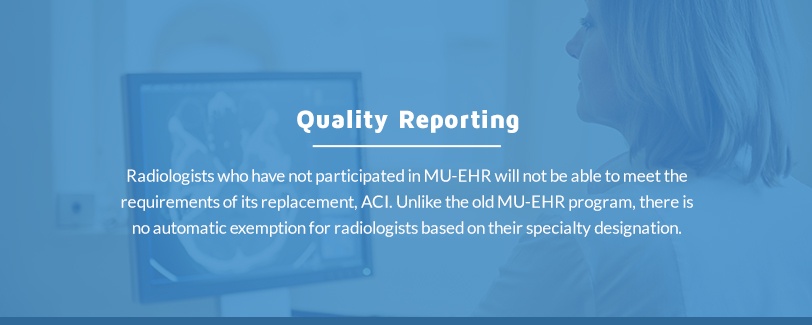 Looking for our latest article on the 2018 updates? Click here.
Looking for our latest article on the 2018 updates? Click here.
Congress has passed several Acts related to the Medicare payment system over recent years, the provisions of which will begin to take effect in 2017. These changes are embodied in the annual Medicare Physician Fee Schedule Final Rule for 2017 (MPFS) and the Hospital Outpatient Prospective Payment System Final Rule for 2017 (HOPPS). In their initial review of the MPFS, the American College of Radiology (ACR) indicated that it “is pleased with several provisions within the rule.”
Medicare Physician Fee Schedule (MPFS)
Overall, the fee schedule conversion factor was proposed to be reduced by 0.14% but in the final rule it was increased by 0.24%. The Centers for Medicare and Medicaid Services (CMS) estimates the overall impact to radiology will be a 1 percent increase, while interventional radiology is expected to suffer a 1 percent decrease. However, each individual practice’s increase or decrease will depend on the modality mix they experience, including the mix of professional component versus global billing.
In our July 2016 review of the proposed MPFS for 2017, we highlighted the following areas of importance to radiologists:
- Bundling of Mammography and CAD Services
- Phase-out of Multiple Procedure Payment Reduction (MPPR)
- Payment reductions for non-digital imaging
- Revision of the pricing of digital imaging following evaluation of the cost of Picture Archiving and Communication Systems (PACS)
- Appropriate Use Criteria and Clinical Decision Support
These remain the primary focus of the final rule as it relates to radiologists.
Bundling of Mammography and CAD Services
All mammography services, whether diagnostic or screening, using digital or film screen equipment, and including computer-aided detection (CAD) will be billed using the set of three existing codes (G0202, G0204 and G0206). The separate charge for CAD has been eliminated. The new bundled codes will provide increased reimbursement for diagnostic exams over the old separate codes, while the screening exam is unchanged. CMS has indicated that these G-codes will be replaced in 2018 by standard CPT codes.
Phase-out of Multiple Procedure Payment Reduction (MPPR)
The MPFS formalizes a provision of the Consolidated Appropriations Act of 2016 that reduces the penalty applied to the professional component of multiple services provided by a practice to the same patient on the same day. Beginning in 2017, payment for such multiple services will be reduced by only 5% rather than the 25% that has been in effect for several years. Our recent article covers the MPPR in more detail. This change will apply to professional component reimbursement whether billed separately or as part of a global fee.
Payment Reductions for Non-digital Imaging
There will be payment reductions for diagnostic imaging that uses x-ray film or computed radiography (CR) rather than direct digital image processing, a provision that was also mandated by the Consolidated Appropriations Act of 2016. The Medicare reimbursement penalty for using plain film will be 20% beginning in 2017. The penalty for CR will begin at 7% in 2018 through 2022, and then become 10% beginning in 2023. The reduction will be to the technical component when it is billed separately, or to that portion of the global fee that represents the technical component. A new modifier (modifier “FX”) will be used to signify claims for plain film imaging.
Revision of the Pricing of Digital Imaging Procedures
Following evaluation of the cost of Picture Archiving and Communication Systems (PACS), the pricing of around 500 CPT codes for digital imaging procedures will be adjusted upward. CMS has determined that the cost of a PACS professional workstation is $14,616.93 rather than the lower figure that had been used previously, and factoring in this information will produce a higher relative value unit (RVU) valuation for those procedures.

Appropriate Use Criteria and Clinical Decision Support (AUC/CDS)
The MPFS indicates that the use of AUC/CDS systems will be required beginning January 1, 2018. Under this rule, radiologists will be penalized through reduced Medicare payments when referring physicians do not order certain imaging examinations using an approved system. The eight clinical priority areas that will be included initially are:
- coronary artery disease (suspected or diagnosed)
- suspected pulmonary embolism
- headache (traumatic and non-traumatic)
- hip pain
- low back pain
- shoulder pain (to include suspected rotator cuff injury)
- cancer of the lung (primary or metastatic, suspected or diagnosed
- cervical or neck pain
The MPFS final rule includes the requirements of the Clinical Decision Support Mechanism (CDSM) to be used. A CDSM is defined as, “an interactive, electronic tool for use by clinicians that communicates AUC information to the user and assists them in making the most appropriate treatment decision for a patient’s specific clinical condition.“ The CDSM tool can be an integral part of an existing electronic health records system or a stand-alone system as long as it is certified by CMS as a qualified system. Vendors will be able to apply for qualification no later than March 1, 2017 with the list of qualified systems becoming available from CMS by June 30, 2017. Thus, radiology practices will have six months, July – December, 2017, in which to select, implement and train ordering physicians to use their system or be ready to suffer penalties in 2018.
Hospital Outpatient Prospective Payment System (HOPPS)
Although the HOPPS rules are meant to govern Medicare payments to hospitals for the technical component of outpatient services, certain aspects of this payment system affect payments to radiologists under the MPFS. For example, the reimbursement level for the technical component of certain imaging center procedures is limited by the HOPPS fee schedule if it is a lower amount than the fee under the MPFS. In the 2017 HOPPS Final Rule, there are two areas that will affect payments to imaging centers.
APC Restructuring
As part of a restructuring of the Ambulatory Payment Classifications (APC) used in the HOPPS coding system, MRI and MRA’s have been placed into a lower payment category that, according to the American College of Radiology, “will undoubtedly have negative effects on their technical component payments in the physician fee schedule for CY 2017.”

Site Neutral Payments
The other area that will affect payments to certain imaging centers is the site neutrality requirement put in place by the Bipartisan Budget Act of 2015. Services provided in facilities, including imaging centers, that are owned by a hospital but which are not located on the hospital campus will be paid for under the MPFS rather than under the HOPPS. Facilities operating prior to November 2, 2015 are exempted from this rule and will continue to be paid under HOPPS until they are relocated or sold.
This rule will result in lower payments to the facility, as it sets the level for 2017 at 50% of the HOPPS fee schedule amount. Note, however, that only the technical component is reduced even if the facility uses global billing, so the professional reimbursement to radiologists should not be affected. Radiologists practicing in imaging centers subject to this rule will want to review their compensation arrangements with the facility, especially if they are based on a percentage of the fee schedule.
Other Regulatory Changes for 2017
Quality Reporting
Much has been written about the effect on Medicare reimbursement due to fee schedule adjustments under the various quality programs like PQRS, MU-EHR and VM. Payment adjustments for 2017 have already been determined based on quality data reported for 2015. In 2017, a new system of quality reporting begins that will determine Medicare fee schedule adjustments for 2019. Even minimal participation in 2017 will be enough to avoid the 4% fee schedule reduction in 2019, and this is well within the reach of almost any radiologist or group practice.
Known as the Quality Payment Program (QPP), the new system was created by the Medicare Access and CHIP Reauthorization Act of 2015 (MACRA). For most radiologists the branch of the two-pronged QPP will involve participation in the Merit-based Incentive Payment System (MIPS). MIPS combines aspects of PQRS (called Quality), MU-EHR (called Advancing Care Information or ACI) and VM into one program, and it adds a new reporting category called Improvement Activities (IA). Eligible Clinicians (ECs) will earn points on a scale from zero to 100 as follows:
Radiologists who have not participated in MU-EHR will not be able to meet the requirements of its replacement, ACI. Unlike the old MU-EHR program, there is no automatic exemption for radiologists based on their specialty designation. Thus, they would not be able to earn a maximum score under MIPS. However, there are provisions in the law for exemption from ACI if the radiologist is deemed to be “non-patient facing”. Meeting this exemption would shift the total MIPS scoring to be 85% Quality and 15% IA. The new program is complex and is beyond the scope of this article, but subscribe to this blog to receive future in-depth articles on MIPS as they are published.

The other avenue available under the QPP is to participate in an Advanced Payment Model (APM), the new term for Accountable Care Organizations (ACO). Radiologists have not generally participated in these organizations, and the requirements of the new APMs are more stringent than those of the old ACOs.
ICD-10 Coding
While not a new regulation, it is worth noting again that the one-year grace period for non-specific diagnosis coding under the new ICD-10 system expired on October 1, 2016. Practices that have not reviewed and adjusted their coding will be subject to denials from Medicare. Our article from August 2016 has all the details.
Conclusion
In addition to everything we’ve already covered, there annually are changes in CPT coding and relative value unit (RVU) assignments that will affect the final fee schedule. The analysis of these areas is not yet complete, but when it is available we will publish an update on coding changes and their pricing effect.
The most effort in 2017 will likely be expended on successful participation with the MACRA QPP to avoid a penalty in 2019. This complex new program is still being developed and everyone is working to understand it. In addition, radiology practices will have to embrace AUC/CDS and work with their hospital and imaging center staff to implement a working system by December 31, 2017. Referring physician education and acceptance will be a big challenge, as well.
Healthcare Administrative Partners is committed to assisting our clients and blog readers to maximize reimbursement through education and understanding of these ever-changing rules and regulations. Subscribe to our blog today to stay up-to-date.
Related articles:
Finalized MACRA Rules for 2017 Contain Some Good News for Radiologists
CMS Issues Its Proposed 2017 Medicare Physician Fee Schedule Rule






